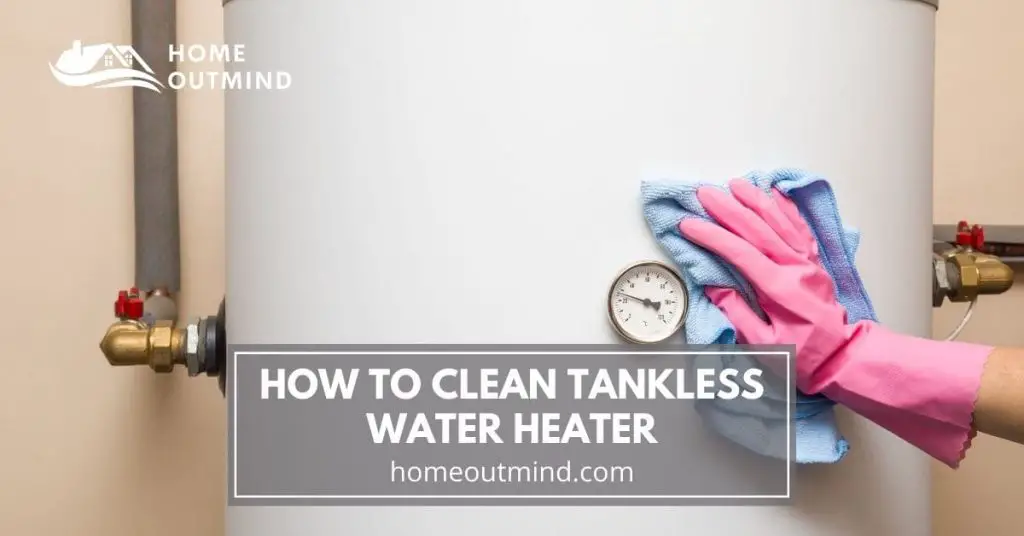Regular cleaning of your tankless water heater is essential for its longevity and performance. If you’re unsure about the process, follow these instructions carefully.
By maintaining cleanliness, you can prevent issues like mineral buildup and ensure a constant supply of hot water. Let’s begin the cleaning process.

Step 1: Assessment
After about six months of use, assess your tankless water heater for sediment buildup, which can affect its performance.
Step 2: Preparation
- Switch off the water heater’s circuit breaker or remove its fuses for safety.
Step 3: Flushing the System
- Open a hot water faucet and let it run until the water cools down to reduce scalding risk.
Step 4: Connecting the Drain Hose
- Attach a garden hose to the drain valve, ensuring the other end is directed towards a drain or suitable outdoor area.
Step 5: Turning Off Water Supply
- Shut off the cold water supply valve connected to the water heater.
Step 6: Opening the Drain Valve
- Open the drain valve on the water heater and simultaneously open a hot water faucet to aid drainage.
Step 7: Inspecting and Replacing the Anode Rod
- While draining, inspect the anode rod for signs of depletion. Replace it if necessary to prevent corrosion and leaks.
Step 8: Flushing the Tank
- If sediment is present, flush the tank by opening the cold water supply valve until no more sediment drains out. Close the drain valve afterward.
Step 9: Refilling the Tank
- Refill the tank by opening the cold water supply valve. Keep a hot water faucet open to release air until the tank is fully filled.
Step 10: Restoring Power
- Restore power to the water heater and allow time for the tank to heat up, usually around two hours.
How to clean tankless water heater with vinegar?
Step 1: Disconnecting Power
- Turn off the electricity supply to the water heater.
Step 2: Closing Valves
- Shut off the shutoff valves on both hot and cold water lines.
Step 3: Connecting Hoses
- Attach a pump outlet hose to the cold water line at the service valve, and connect a drain hose to the service valve.
Step 4: Preparing Cleaning Solution
- Pour four gallons of undiluted, food-grade white vinegar into a pail.
Step 5: Initiating Cleaning
- Start the pump and let the vinegar solution flow through the water heater for at least an hour at a rate of four gallons per minute.
Step 6: Rinsing the System
- After cleaning, flush the water heater with clean water for five minutes.
Step 7: Finalizing the Process
- Disconnect all hoses and restore power to the water heater.
Do tankless water heaters require flushing?
Tankless water heater manufacturers recommend flushing their products at least once a year to eliminate the accumulation of calcium and other minerals inside the unit particularly if you have hard water.
Typically, the frequency is annual, unless the water quality is poor, in which case more frequent flushing is advisable.
What happens if you neglect to flush your tankless water heater?
Failure to flush your tankless water heater can lead to the buildup of mineral deposits. This buildup may result in a blockage within the unit, impeding its normal heating operations.
As a consequence, your hot water supply may become inconsistent, and the system may overheat, compromising its efficiency.
Is it possible to flush a tankless water heater yourself?
Yes, you can flush out a tankless hot water heater in approximately one hour. Start by turning off the electrical circuit for the water heater at the breaker panel.
If the water heater is gas-powered, turn the gas cutoff counterclockwise to shut off the gas supply to the unit.
What are the consequences of not flushing your tankless water heater?
While tankless water heaters won’t explode due to sediment buildup, neglecting to flush out the sediment can cause the unit’s heat exchanger to operate harder than necessary.
Regularly flushing out sediment not only enhances the water heater’s efficiency but also helps prevent potential issues.
Can vinegar be used to clean a tankless water heater?
- Fill a 5-gallon bucket containing a submersible pump with 4 gallons of virgin, food-grade, white vinegar.
- Do not mix the vinegar.
- Activate the Hot and Cold Service Ports.
- Power up the Submersible Pump and allow the vinegar to circulate through the tankless water heater for a minimum of 60 minutes.
Can vinegar be added to a hot water heater tank?
To alleviate mineral buildup, you can flush your hot water tank. If this isn’t sufficient, vinegar can be added to your hot water tank to help dissolve the deposits for easier drainage. Similar cleaning techniques can be applied to patio heaters.
However, it’s important to note that vinegar is acidic and can corrode metal. The combination of water and acid promotes rust formation, leading to leaks.
The most effective way to protect a water heater is to prevent hard water scale buildup by using a water softener.
How Often Do You Need to Flush Water Heaters?
Typically, water heaters should be flushed at least once a year. However, households with hard water or heavy usage may benefit from flushing every six months. It’s essential to monitor your water heater’s performance and adjust the flushing frequency as needed.
Here’s how to determine how often you should flush your water heater:
Step 1: Assess Your Water Quality
Start by assessing the quality of your water supply. If you have hard water with high mineral content, you may need to flush your water heater more frequently.
Step 2: Consider Manufacturer Recommendations
Check the manufacturer’s recommendations for your specific water heater model. They may provide guidelines on flushing frequency based on factors such as water hardness and usage patterns.
Step 3: Evaluate Usage Patterns
Consider how much hot water your household uses on average. Higher usage often leads to more sediment buildup, necessitating more frequent flushing.
Step 4: Monitor Performance
Pay attention to any signs of reduced efficiency or performance issues with your water heater. If you notice slower heating times or fluctuating water temperatures, it may be time to flush the system.
Step 5: Implement a Schedule
Based on the above factors, establish a regular flushing schedule that works for your household. For most homes, flushing the water heater once a year is a good starting point. However, households with hard water or heavy usage may benefit from flushing every six months.
Step 6: Adapt as Needed
Be flexible with your flushing schedule and adjust it as necessary. If you notice increased sediment buildup or performance issues between scheduled flushes, consider flushing more frequently.
Step 7: Professional Assessment
Periodically, have a professional plumber inspect your water heater and assess the need for flushing. They can provide expert advice tailored to your specific situation and ensure your water heater remains in optimal condition.
Frequently Asked Questions
How to fix a water heater pilot light?
Fixing a water heater pilot light is a manageable task with the right approach. Start by turning the control knob to “Pilot” and holding it while igniting the pilot light. If the light doesn’t ignite, wait 10 minutes before trying again.
Check for loose connections or faulty components, such as the thermocouple or gas supply. For detailed troubleshooting steps and safety precautions, explore our comprehensive guide on How to Fix a Water Heater Pilot Light.
How to install hot water heater element?
Installing a hot water heater element requires precision and attention to detail. Begin by turning off the power and draining the tank partially. Remove the access panels, disconnect the old element, and install the new one securely.
Reconnect the wires and ensure proper alignment to prevent leaks. For step-by-step instructions and safety tips, refer to our detailed guide on How to Install Hot Water Heater Element.
How to turn up hot water heater electric?
Adjusting the temperature on an electric hot water heater is straightforward. Locate the thermostat panel, remove the cover, and adjust the temperature dial to your desired setting. Remember to consider energy consumption and the risk of scalding.
For detailed instructions and temperature adjustment tips, consult our guide on How to Turn Up Hot Water Heater Electric.
How to test a water heater element?
Testing a water heater element is crucial for ensuring efficient operation. Start by turning off the power and draining the tank partially. Disconnect the wires from the element and use a multimeter to measure the resistance.
Compare the reading to manufacturer specifications to determine if the element is functioning correctly. For a thorough guide on testing procedures and troubleshooting tips, explore our article on How to Test a Water Heater Element.
How to light a gas water heater?
Lighting a gas water heater is a straightforward process with proper guidance. Start by turning the control knob to “Pilot” and holding it while igniting the pilot light. Once lit, release the knob and set it to the desired temperature.
For detailed instructions, including safety precautions and troubleshooting advice, refer to our comprehensive guide on How to Light a Gas Water Heater.
Final Verdict
By following these steps and staying proactive with maintenance, you can keep your water heater running smoothly and avoid costly repairs or premature replacement.
Regular flushing removes sediment and mineral buildup, allowing your water heater to operate efficiently and provide reliable hot water for your household’s needs.

